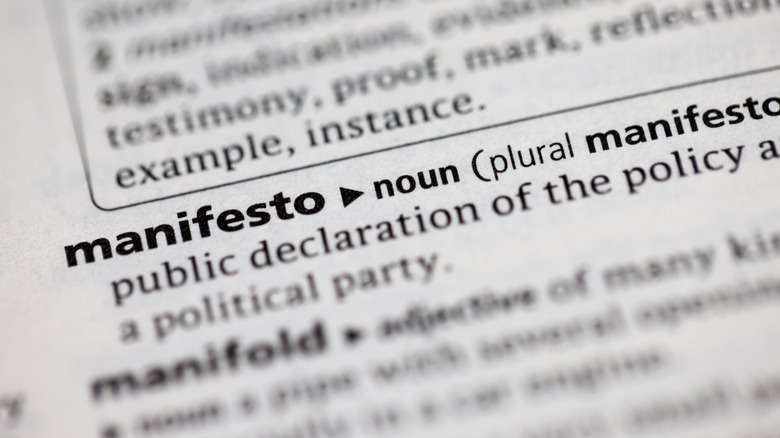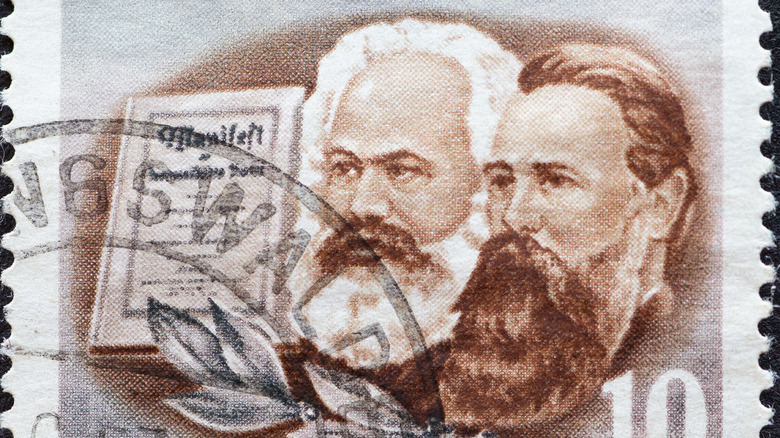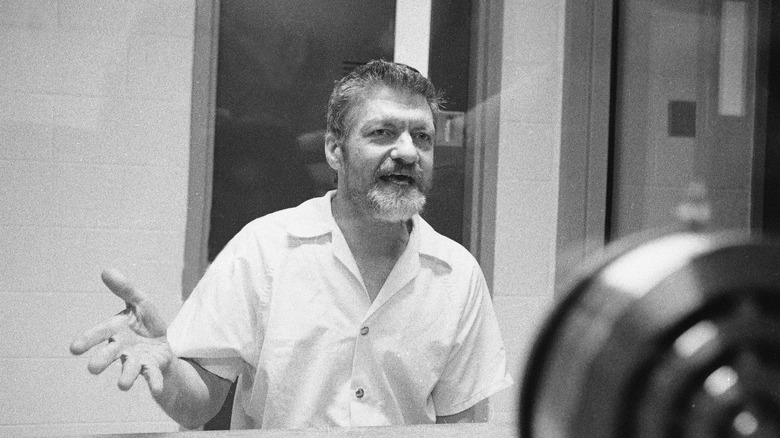What It Really Means For Someone To Have A Manifesto
On May 14, 2022, as NBC News reported, a mass shooting took place at a supermarket in Buffalo, New York. Authorities began investigating the act as a hate crime, for several reasons, not the least of which was that the majority of victims were Black. The alleged assailant, a white man identified as 18-year-old Payton Gendron, also live-streamed the attack on Twitch. Authorities believe they identified a manifesto Gendron had written in which the author references white-supremacist beliefs and rallying points, and purportedly even laid out the author's plans for a mass shooting. It bears noting, however, that as of this writing, though circumstantial evidence does point to the document as having been written by the alleged shooter, this has not been conclusively proven.
The word "manifesto" often comes up in stories such as these, as more than one mass shooter or terrorist has written one. Further still, at least one philosopher has published a manifesto, and indeed, of late the word has taken on a considerably darker meaning than what it once met.
What Even Is A Manifesto?
The dictionary definition of the word "manifesto" is remarkably straightforward: coming from the same Latin root that gives us the word "manifest" -– to make obvious or real –- as Merriam-Webster notes, it's simply a statement of the beliefs of the writer (or the writer's group or political party or whatever). Nothing more, nothing less. Though it has come to have negative connotations due to its associations with terrorism and violence, the dictionary gives a rather anodyne example of its use: "The group's manifesto focused on helping the poor and stopping violence." By this narrow definition, even the Declaration of Independence or the Nicene Creed can be considered manifestos.
Of course, as mentioned above the word "manifesto" has taken on some historical baggage, and it has probably been moving in that direction for nearly two centuries. That's because what is probably the biggest example of the word comes in the title of Karl Marx and Friedrich Engels' "Communist Manifesto," which laid out the beliefs and goals of their political group.
The Communist Manifesto
Engels and Marx wrote the big daddy of them all, "The Communist Manifesto," published in 1848. Its influence, though controversial, cannot be denied. Boiling down the lengthy document — which touches on multiple social, political, historical, and philosophical topics — to its essence would be a fool's game, but (very) long story short, the document claims that all of human history can be traced in one way or another to class struggles. The writers wrote that the proletariat – the working classes – could put an end to such a stratified society forever.
The document was little-noticed at first, according to History, but within a few decades, it would inform major cultural and economic shifts in Russia and Eastern Europe. The repercussions of those shifts are still being felt today.
Though the word "manifesto" has always been neutral, its association with screeds advocating for violence might have begun with this document. For example, the document clearly and unambiguously calls for "forcible overthrow of all existing social conditions." Further still, Marx himself was a bit more obvious about his methodology in a newspaper article, also in 1848: "There is only one way in which the murderous death agonies of the old society and the bloody birth throes of the new society can be shortened, simplified and concentrated, and that way is revolutionary terror," he wrote.
Payton Gendron's purported manifesto
As The New York Post reports, authorities have identified a 180-page document that they believe is alleged Buffalo shooter Payton Gendron's manifesto. Described as a "diatribe" by the newspaper, the document lays out in exacting detail the writer's step-by-step plans to carry out a mass shooting. The writer claims that he was self-radicalized on 4chan, after getting "bored" in the early days of the coronavirus pandemic.
Further, as NBC News reports, the missive was posted to Google Docs about 48 hours before the shooting and contained a birth date and other biographical details consistent with the alleged shooter. Central to the document's narrative is the writer's belief in the idea, popular among white-supremacist elements, that the white majority in the United States is being replaced by immigrants and other minority communities, as part of some elaborate Jewish conspiracy. The writer also claims that so-called "critical race theory" is actually a Jewish plot, and the writer uses that as justification for murdering Jews.
Other Manifestos
The May 2022 Buffalo shooter was not the first American murderer who carried out a mass shooting and/or a terrorist attack and who also had a manifesto. A decade before he was even born (if indeed the Buffalo shooter and the manifesto writer are both Payton Gendron, which has not been proved in a court of law as of this writing), a domestic terrorist with the nickname "The Unabomber" also published a manifesto.
"Industrial Society and Its Future" is a 35,000-word essay in which the writer, Ted Kaczynski, rails against industrialization and its impact on the environment, among adjacent topics. As The Washington Post reports, the terrorist sent copies of the document to both that paper and The New York Times, and promised another bombing if it wasn't published, so with the encouragement of the FBI, the Washington Post published it.
Another terrorist with a manifesto was Brenton Tarrant, who killed 51 people in two shootings at mosques in Christchurch, New Zealand in 2019. As Vox reports, the manifesto contained white-supremacist language as "justification" for his actions.
Reclaiming the manifesto
As mentioned above, the word "manifesto" is, at least in terms of words on paper in the dictionary, perfectly neutral, and can mean anything from a screed describing a terrorist's motivations, to a forward-thinking group's explanation of their goals, and everything in between.
None other than Master Class treats the word completely neutrally, and even gives readers advice for penning their own manifestos. That advice includes a directive to be clear and concise, to write with respect towards your intended audience, and to include a call to action rather than just an explanation of your beliefs.
Similarly, Swarthmore University, at least in this particular context, treats the writing of a manifesto as a sort of homework assignment, an exercise in getting the student to clearly articulate who they are and what they're about. The professor who wrote the assignment also notes that writing a manifesto is itself practice, of a sort, for writing grant proposals, a job duty that many students may have to do later in their careers.





